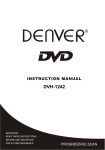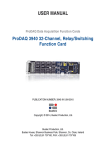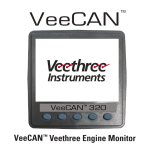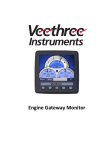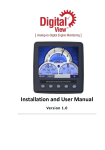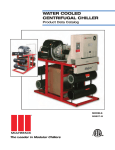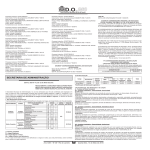Download LASS user manual
Transcript
By LASS USER MANUAL This document describes the operation of the LASS program for acoustical prediction, design and optimization of loudspeaker line arrays utilizing systems from SLS Loudspeakers. The LASS (Line Array Simulation Software) is a comprehensive design tool developed by SLS Loudspeakers. It is distributed free of charge and is available for download from www.slsloudspeakers.com Contents 1. 2. 3. 4. 5. 6. 7. Introduction General considerations about acoustical simulation of line arrays Installation Overview Things to consider when designing line array systems Design procedure step-by-step - Detailed practical example LASS-EASE interface - Creating data for EASE projects 1. Introduction SLS’ Line Array Simulation Software (LASS) provides a quick way to predict direct SPL distribution of line arrays in a wide variety of venues in two-dimensional space (most commonly in the vertical plane). In addition, it provides a number of other valuable tools including: Manual and automatic optimization of splay angles The ability to chart direct SPL coverage across listening planes at various frequencies Frequency response mapping at any point in the venue Minimum, maximum, and average SPL predictions Array SPL wave-front predictions at various frequencies and distances Automatic calculation of size and weight of the array Automatic calculation of center of gravity of the array Project report generation, exporting related graphics © SLS Loudspeakers, 2005 LASSMN-040105 1 2. GENERAL CONSIDERATIONS ABOUT ACOUSTICAL SIMULATION OF LINE ARRAYS Polar diagrams that we commonly use to describe directivity of a loudspeaker are relevant only for far field conditions and should be used accordingly. In simple terms, if the distance between a loudspeaker system and a microphone is many times larger than size of transducers used in a system and/or distance between individual transducers, then far field condition will be met. If the microphone is closer than that, then we could say that it’s located in the system’s acoustical near field. The system’s direct sound can be accurately predicted in all directions and for all distances in its far field using polar diagrams. Usually, we assume that for a typical point source loudspeaker it’s far field condition is fulfilled at 1 or 2 meters. It is not the same with line array systems, where one of the system’s dimensions, usually in the vertical plane, can be rather large (three dimensional “matrix” arrays are beyond the scope of this document). The near field of a line array can expand to hundreds of feet. Within this near field, the structure of the sound field is very complex due to interaction between array’s elements. SPL varies with distance in a different, more complex way than can be described by simple spherical wave equations. Therefore, if we consider a typical line array system with multiple elements positioned in a vertical plane, a polar diagram measured in that plane within the array’s near field will be valid only for that particular distance and cannot be used for SPL predictions at other distances. This is why one must use calculations for prediction of a line array’s vertical dispersion within its near field. This is one of the pivotal points of line array theory that many are confused about. LASS is a sophisticated program that uses a complex proprietary FEA algorithm to accurately calculate SPL distribution of line arrays. Most other simulation programs use simplified algorithms and are less accurate. LASS accounts for all near field effects and also for the inevitable gaps between line array elements. Due to the fact that SLS ribbon drivers represent almost ideal continuous ribbon line source, LASS predictions, based on flat piston approximation, produce extremely accurate results with SLS line arrays. These results have been practically tested and proven in real life applications where SLS line array systems were installed. 3. INSTALLATION If installing LASS for the first time, create a new ‘LASS’ folder on your computer. It is recommended that you set up the LASS directory either in C:\LASS or in C:\Program files\LASS. Extract the zip file to that folder, and run the LASS application. If updating a previous version of LASS; delete the old LASS***.exe program file and all *.lspk data files from your LASS folder. Extract new LASS***.exe, LASSEASE.dll and *.lspk data files to your LASS folder. Note: If you had an early version of LASS, which reversed the inclination angle, you must open existing .LLA files and change the inclination angle to the appropriate (+) up or (-) down indication. © SLS Loudspeakers, 2005 LASSMN-040105 2 4. OVERVIEW LASS uses dimensions of the venue and listening areas (listening planes) based on a section through the space to create a virtual model. The dimensions are entered in the Listening Plane parameters window by pressing the corresponding tab (bottom left, see left). The starting point is Xa and Ya, where Xa is a horizontal coordinate typically representing the start of the listening plane you want to cover, Xb, then, would be the end of that plane. Ya is the elevation of the plane (if any) above the floor. Yb is used to set the floor’s rake – or height at the back of the seating plane. Additional listener planes are then entered as necessary, and balcony surfaces can also be entered as independent listener planes. Listening planes can also be entered by clicking and dragging between two points, and selecting the appropriate command from the pop-up menu. One can also model areas outside of the main listening area if desired (such as the stage), provided you remember to de-activate them prior to running the AutoOptimization sequence. Listening Planes Next, the Parameters tab (bottom, second from left) provides a pull-down menu for the Module selection (array element model), the height and position of the array (X-Y coordinates correspond to the top frontal point of the upper element), number of elements desired for the array, ear level, and “0-dB” reference point (X ref-Y ref), among others. The 0-dB reference point (indicated by the green “brain”) is the reference for SPL variation calculations (mapping is performed in the Plots window), and typically represents the mix position or a general reference point such as a point 2/3 of the way into the venue. © SLS Loudspeakers, 2005 LASSMN-040105 3 Parameters The Show SPL Values/Draw Lines button accesses a number of other functions. With the button in the out position, the left mouse button can be clicked to activate a dual-function pop-up menu. The 0-dB reference point can also be repositioned by clicking on the new reference position (Point A), and selecting the “Move 0-dB ref. point” or “Move 0-dB ref. point on listening plane” functions. Other functions include, the ability to reposition the array, predicting the frequency response at Point A*, and moving listening planes by clicking and dragging from the old position to the new and selecting the desired function. The Show SPL Values/Draw Lines button in the in position allows the user to check the variation of SPL at any point (referenced against the 0-db ref. point), by clicking and dragging or selecting any given point. LASS calculates and displays the frequency response of a direct sound field at a point relative to the 0-dB Ref point’s direct sound response, which is assumed to be flat. The Optimization tab provides a number of features that greatly simplify array design. First, the number of elements can be adjusted using bump buttons. © SLS Loudspeakers, 2005 LASSMN-040105 4 Next, the Inclination bump buttons are used to adjust the array tilt-angle up or down in half-degree increments so that the on-axis aim point (gray line) of the top element hits just above the rear of the listening plane (see below). Next, the Coverage bump buttons are used to aim the on-axis aim point of the bottom array element so that it hits the ear height at the first listening position. Optimization The Articulation and adjacent Auto-Optimization button are used to start the optimization cycle to find the best splay angle pattern (articulation) that results in the lowest standard deviation of direct SPL along the listening lines throughout the whole venue. The Large Step button is provided to speed up preliminary calculations and uses significantly fewer points on the listening plane. You can press and depress this button at any time. Note: Most accurate predictions are obtained when the Large Step button is not activated. Also, make sure to deactivate (uncheck) listening planes outside of the main coverage area to ensure accurate predictions. In most cases, this means deactivating listening planes used to draw stage positions, etc. The Optimization tab also provides SPL calculations. Use the Wide Band SPL button for SPL prediction that correlates with subjective perception of loudness. Wide Band SPL opens a window that shows max, min and average SPL and its dispersion (standard deviation) over all listening planes. The window on the right in this case depicts absolute SPL plots along the listening plane - over the wide frequency band. Note that the ground floor listening planes and the balcony listening planes are indicated in different colors. The Coverage button and Articulation Auto Optimization button only operates when the system is in the Auto-Splay Mode. This is selected with the icon in the center of the top menu bar. © SLS Loudspeakers, 2005 LASSMN-040105 5 Auto Splay Mode Manual Splay Mode Note: The LASS optimization engine finds the lowest high frequency SPL dispersion (mathematically expressed as standard deviation) as optimization criteria to ensure smooth coverage throughout the venue at all frequencies. You can see high-frequency absolute SPL distribution along listening planes that is subject to optimization in the window in the right bottom corner. After the Optimization process has been run, you can map the coverage of various frequencies, using the Mapping button. Variations in SPL can be referenced against the 0-dB Reference Point by clicking and dragging across the listening planes, or clicking at any point in the Dispersion Window. The map may also be saved for use in documentation and proposals, using the Clipboard function under the main File menu. Starts Mapping LASS also provides large-scale plots showing SPL variation over distance. This is done by depressing the Plots tab at the bottom of the screen. These plots show variation in SPL over the listening planes, and various frequencies can be selected to check coverage. The planes are indicated with different colors as well as corresponding SPL curves, so SPL and frequency variations can be compared between listening planes. © SLS Loudspeakers, 2005 LASSMN-040105 6 LASS also provides an Array Window, showing center-of-gravity predictions (in green) for the mounting grids, as well as height and weight of the array. These graphics can also be saved to the windows clipboard for use in documentation. Graphic documentation for the entire project (frequency response plots, array window graphics, etc.) can also be exported using the Reports menu button. Create Report View array geometry 4. THINGS TO CONSIDER WHEN DESIGNING LINE ARRAY SYSTEMS One should always to remember is that line array coverage predictions are never straightforward and cannot be observed using the classical point source approach. Line array dispersion characteristics are much more complex and need tools like LASS to be accurately simulated 4.1 Direct vs. reflected and reverberant sound Even though reverberation is a very important factor in room acoustics, it is still secondary to direct sound. In some cases room effects can be equalized if the room has less than optimal acoustics. However one has to be very cautious with room equalization. It is known that certain response aberrations induced by the room, especially by early reflections generally are non-minimum phase nature and as such cannot be easily corrected with equalization. A simple example is a comb-filtering effect cased by early reflections from nearby surfaces or off the floor in front of the listeners. Therefore it is a good practice to design a system with proper direct sound coverage. LASS serves just this purpose. Having pointed out the primary importance of direct sound coverage, one must always consider reverberation and its possible effects. LASSEASE.DLL program © SLS Loudspeakers, 2005 LASSMN-040105 7 should be used to combine LASS algorithms with EASE for comprehensive acoustic simulation in rooms. 4.2 On spectral balance variations of line arrays with distance In general, properly coupled line array systems easily deliver mid and High frequency energy over large distances. The near field in which SPL falls off with less than 6 dB per doubling of the distance (theoretical near field attenuation rate is 3 dB) extends very far away in upper midrange and High frequency band. At the same time the near field for lower mid and low frequency range is not as expended and SPL starts dropping off at 6 dB per doubling of the distance sooner or closer from the source. This leads to a gradual tilt towards High frequency at far distances. This effect may partially be compensated by air absorption if distances are large enough (over 150-200 feet). However in most cases air absorption is not so significant and in outdoor applications a line array may sound too bright at far distances. In many cases this may not be objectionable since this helps to obtain good intelligibility, but if accurate spectral balance is paramount, certain measures may be required. If hardware and wiring configuration allows for equalization of certain segments of the array, then High frequency tapering of upper (long-throw) modules may help to balance the system. Another solution would be using additional low frequency only elements that effectively extend the length of the array and thus extending the lower mid and low frequency near field further. We would like to call it “Dimensional low frequency extension” (DLFE). For indoor applications, in most cases, the high frequency tilt, as practice shows, is not a problem at all but a great benefit. A room would generate additional reverberation energy that would have a spectrum with low frequency tilt at large distances that compensates the system’s high frequency tilt and that normally results in fairly balanced performance and amazingly good intelligibility in comparison with conventional point source systems. In some cases, in very reverberant rooms (churches or other large spaces with hard surfaces), utilizing DLFE technique could be extremely beneficial. If DLFE for outdoor applications provides near filed extension at low frequency and as a result more direct SPL further into a venue, in this case DLFE additionally helps to get a better dispersion control in critical 100-300 Hz band. This reduces a reverberation build up and greatly improves intelligibility. DLFE allows additional dispersion control without creating unnecessary mid and High frequency reflections that would have been imminent with a full range system of the same size. 4.3 Sensitivity of line array aiming and positioning Line array performance, particularly on the edges of coverage areas, greatly depends on precise positioning and aiming. It is different than with a point source system. Due to extremely controlled dispersion, especially at high frequency, there is a danger of leaving a certain number of listeners with a dull, significantly attenuated sound. When rigging a system, it is recommended to use an electronic inclinometer positioned on the bumper bar. Also, a laser distance meter is indispensable tool for upper module height verification directly from the ground. © SLS Loudspeakers, 2005 LASSMN-040105 8 5. STEP-BY-STEP - DETAILED PRACTICAL EXAMPLE 5.1 Drawing, saving and opening a venue model The design goal of any loudspeaker simulation software is to configure a speaker system so that it provides desired coverage and loudness levels along listening planes throughout a venue. In some cases, avoiding certain areas can also be desirable, especially in cases where vertical surfaces might cause strong reflections. Drawing the venue’s vertical geometry in the LASS is an important step in designing a line array system. A venue is represented by its cross-section and listening planes represent audience areas. Let’s take a medium size, 120 feet deep, venue and design a cost effective line array for live music performances with average continuous SPL reaching 110 dB. The LASS algorithm simulates direct sound only, meaning it does not account for reverberation that generates room gain effect. For indoor applications, room gain leads to additional SPL increase over direct sound SPL. The further we move away from the source, the more reverberant sound energy we may experience. Although room acoustic parameters, including reverberation effects, are out of the scope of LASS simulation, we will show that moderate low and mid frequency room gain will often have positive results when using line arrays. Namely, it compensates for some high frequency tilting typical for line array systems due to specific sound propagation effects in the near field. Fig 5.1 depicts the System Configuration Window, schematically showing the venue’s cross-section and coordinates of the listening planes in the Listening Planes specification window. Fig. 5.1 System Configuration Window The color of each listening plane bump button in the Coordinate Definition Window corresponds to the plane’s color in the system configuration window. There are seven listening planes available in the program. The coordinates © SLS Loudspeakers, 2005 LASSMN-040105 9 representing starting and ending points of listening plane are entered manually into appropriate boxes. The venue is 120 feet deep with maximum balcony seating elevation at 22 ft. The distance numbers under the planes indicate their length. Note: Since LASS deals with only direct sound; it is not necessary to include venue details that are small in size. These small details can be referenced with straight lines. Also, it is better to use as few planes as possible since it will speed up calculation process. Notice that plane #6 represents a space without seats, 16 feet deep, in front of the stage. Plane #7 represents a stage segment, 4 feet high, where microphones are usually placed. These two planes are specified optionally to show that a user can analyze SPL attenuation outside of the targeted coverage area. This could be useful in determining optimum microphone placement for the lowest feedback or in analyzing SPL in other areas were a designer wants as less sound energy as possible (for instance, avoiding hard reflective surfaces in a church or airport, houses located nearby of an outdoor event etc.). Note: when running the optimization cycle you must turn off the optional planes that are located outside of the coverage area by leaving their check boxes unmarked. In general, it is better to avoid specifying planes outside of the coverage area unless it is necessary. In most cases it is sufficient to use the mouse pointer to verify relative SPL attenuation in those areas. If the user forgets to turn these planes off during optimization, they will be included in calculations and the result will be incorrect. The System Configuration Window has coordinate axis with sliders that allow panning through the venue, zooming in and out as well. There is large Fit on screen button in the upper left corner of the window for quick optimal positioning of the whole system on the screen. An optional grid can be turned on or off through View, Grid in the main menu. If you want to remove a plane from the calculation and optimization process, you should unmark the appropriate check box. At this point it is recommended to save the project. In the File menu above, you can choose Save or Save As to save your project in Projects (or any other) folder. Most menu functions are self-explanatory. You can also create New, Open existing or Create Default project using menu functions. A saved LASS project has specific ***.LLA format. 5.2 Specifying system parameters The next step after defining the listening planes is to specify initial system parameters. This process has an intuitive component but the user should have a general understanding of the basic acoustic principles. Clicking the Parameters key opens a window where various system configuration and general setup parameters are specified (see Fig.5.2). © SLS Loudspeakers, 2005 LASSMN-040105 10 Fig. 5.2 Parameters Window At the top of the first column of the drop-down menu list called Model. Select the array element model number you wish to use. We will choose LS8800 (RLA/2) module for this system. The LS8800 is a very versatile, cost effective, compact and lightweight module with high maximum SPL and excellent sound quality. The next two parameters below, X and Y, specify coordinates of the mid point on the top frontal edge of the top array box. These normally show the array reference position in the venue. The Elements box specifies the number of the elements (boxes) in the array. We will choose 10 elements for this system. Elements Off parameter allows turning off certain elements. Starting from the top of array, enter the position number(s) of the element(s) to turn them off, separating numbers by a comma. If you choose to start counting from the bottom of the array, the numbers should be negative. This feature can be used for different applications. For example, if one wants to attach two LSB8115 subwoofers at the top of the array and then proceed with LS8800 modules down below, it is easy to simulate such array by entering 1,2,3,4 and turning four upper elements off. The LSB8115 subwoofer is twice the height and weight and can be simulated from geometry standpoint by two LS8800 modules. The two subwoofers will not be considered during acoustic simulations since they are crossed over to LS8800 below 100Hz, but it is important to account for them when calculating weight, center of gravity coordinates and array dimensions. The Elements Off parameter may also be used for simulation of intermittent arrays, or whenever two or more array sections are used with their axis aimed in one vertical plane. Inclination defines the angle of array inclination, which usually is the angle of inclination of the top element/bumper bar. In order to cover the ear level of the furthest person in the venue, we specify inclination at –4.5 degrees for our current design, slightly pointing the array down. The upper dashed line, indicating © SLS Loudspeakers, 2005 LASSMN-040105 11 acoustic axis of the upper element, should pass right through or just slightly above the listening plane (ear level). Ear level specifies the height of a listening plane. Typically, seated listeners are set at 3.5’ and standing listeners are 5.7’. Xref & Yref are the coordinates of the “green cloud” which represents the mixing or reference position. It is used as a reference position where frequency response is assumed to be flat at 0 dB. All other frequency response curves in other venue points are calculated based on this assumption, relative to the reference point. We placed the reference point at 2/3 within the venue, about 80 feet from the stage. The Grid parameter defines the grid size in appropriate space units that are currently used. Accuracy: This parameter defines the accuracy of the calculations. Lower numbers yields higher accuracy, but increases the time required for simulation and mapping. Recommended values are 6 to 12, where 12 could be used for quick calculations and 6 for more refined analysis. Coverage: This parameter defines the total splay or total coverage angle of all elements. The initial value should be chosen with the axis (dashed line) of the lowest array element aimed straight at or slightly above the ear level in the beginning of the closest listening plane. The exact total coverage angle can be finalized after examining plots and frequency response curves. Articulation is a relative parameter, related to the sequence of the splay angles of the array. It has no physical meaning but is mathematically related and defines the splay angle progression. It is used during the design and simulation stage. The Tail Elements parameter specifies the number of elements that are used as down-fill modules below the main array. Using down-fill modules is a very costeffective way to build systems with large coverage angle and high maximum SPL capability, when the main array contains large size cabinets. Down-fill modules have smaller size, allowing for larger, more flexible splay angles and larger overall coverage specifically targeting audience areas below and in the nearest proximity of the main array. Splayed down-fill modules also deliver lower SPL than main modules do, thus maintaining more even SPL throughout the venue without overpowering audience close to the system. Measurement units specify desired units of measurement for the venue (space) and for array modules (devices). 5.3 Mouse pointer and related functional tools LASS extends the functionality of the computer’s mouse. When the mouse is moved on to the System Configuration Window it turns into a “pointer”. In this mode the mouse becomes an additional tool with various functions such is coordinate display, features positioning and relocation, virtual “measurement” tool and much more. The narrow bar at the very bottom is a reference bar. © SLS Loudspeakers, 2005 LASSMN-040105 12 The two sub-windows on the left display current distance (ft.) and system module measurement units (in.). The third sub-window shows current mouse pointer (x,y) coordinates within the venue coordinate system. It also shows the coordinates of starting point “a” depending on the mode of the Show SPL Values/Draw lines . This is located on the top tool bar. In the Draw mode, you can draw button lines in the System Configuration Window with a multifunctional pop-up window appearing afterwards. Pointing the mouse and pressing its left button activates a drawing sequence and specifies the position of starting point “a” with fixed coordinates shown in the third sub-window. Holding the left button and moving the mouse will draw a line. The fourth sub-window in this case will show current (x,y) coordinates of the mouse pointer or “b” point. The fifth sub-window shows the current distance between point “a” and point “b” and the angle between line “a/b” and positive direction of the X axis. Releasing the left button specified the location of point “b” and activates a pop-up window at the top. This provides a quick tool for listening plane and array positioning or position modification. If you move mouse the into that pop-up window and click Move and rotate array, the array in the System Configuration Window will be moved in point “a” and it’s vertical inclination will be set equal to the angle between line “a/b” and X axis. If you highlight Move listening plane # and choose a certain listening plane number, this listening plane will replace line “a/b”. This method is not as accurate as specifying coordinates through manual numerical input, but it allows the user to draw and evaluate different ideas very quickly. If you don’t draw a line, but just click the left button on the mouse, a different type of pop-up window appears. This window provides a different set of functions. Move array quick point-to-point positioning of an array without effecting its rotation. The array’s top box (X,Y) coordinates will be specified in the same position as the chosen point “a”. The reference point (“green cloud”) can also be moved with the same technique. Left-clicking the mouse and choosing Move 0 dB ref. point will move the “green cloud” to point “a”. Choosing Move 0 dB ref. point on listening plane will position the “green cloud” on the listening plane vertically aligned with point “a”. Drawing an “a/b” line with the mouse and choosing Move and rotate array from the pop-up menu will move the array (X,Y) reference point to point “a” and will aim it along the ‘a/b” line. If the Show SPL values/Draw lines button is pressed in SPL mode the mouse pointer will work as a virtual “measurement” tool. Two sub-windows on the right of the reference bar at the bottom will show “SPL relative to ref.” and “Max continuous SPL” in the chosen point at the current frequency. Max continuous SPL is a short-term program level that the system can generate in free field condition without accounting for reverberation. Clicking the left mouse button will put a relative SPL value on the screen. If a line is drawn while the button is in SPL position, SPL values will be depicted along the line. 5.4 Optimizing array configuration Optimization: This button opens a window with various tools. Its function is briefly described on page 4. The optimization algorithm used in LASS is designed to achieve the smoothest SPL coverage with lowest deviation along specified listening planes. The 1/6 octave frequency band for determining the deviation is chosen to be 8 kHz. It is designed to track and fix fine coverage irregularities. © SLS Loudspeakers, 2005 LASSMN-040105 13 Auto Optimization Fig. 5.3 As soon as initial array parameters are defined, pressing the Auto Optimization button (to the right of Articulation) will start the optimization cycle. This is done by calculating the standard SPL deviation along all active listening planes. Then progressively adjusting splay angles between elements until the lowest possible value is achieved. Current standard deviation is numerically depicted at the top of the central window. The motion of red circle in the Optimization Screen graphically shows how standard deviation changes during optimization. Minimum standard deviation curve is the criteria of optimum splay progression between elements. Absolute SPL distribution (1/6 octave, 8 kHz) along all marked listening planes is shown on the graph in the window to the right. If the Large Step button is pressed the number of calculation points along the planes is reduced and optimization process goes faster. However, accuracy is reduced as well. A user can alternate pressing Large Step to speed the process in certain moments for quick preliminary results or when it is obvious that deviation curve has passed its minimum (e.g. at the end to the cycle or when the red dot starts moving up). It is also possible to press the Stop button, which is located below the Auto Optimization start button. When this is done the cycle will stop and the red dot will be positioned in the minimum of standard deviation curve. The optimum correspondent value of Articulation parameter will also be defined at that moment. The user may choose slightly different parameters after detailed examination depending on particular preferences. Pressing Wide band SPL button will switch SPL curves in the SPL distribution along the field window below to absolute levels that are averaged and weighted across wide band of frequencies, approximating C-weighted measurement results. This is a measure that is used to correlate SPL levels in the venue with subjective perception of loudness. At the same time the central window depicts Max SPL, Average SPL and Min SPL across the venue. SPL dispersion is a common statistical measure of parameter deviation. SPL peak values show peak SPL deviations from the Average SPL. Different optimization or system configuration variants (with different modules, number of boxes or coverage angles) can be saved and recalled. The narrow window at the bottom to the left views the information. Use the Save (button with arrow on the right) or Recall (button with arrow on the left). This feature allows quick comparison without saving and opening the project under different names. © SLS Loudspeakers, 2005 LASSMN-040105 14 Fig. 5.4 Fig.5.3 and Fig5.4 show the results obtained after optimization of the 10-element RLA/2 system. The overall high frequency deviation is only +/-1.6 dB throughout the venue, which is exceptional. This means that there will be no significant high frequency “holes” in the coverage. Looking at wide band continuous SPL parameters, we can see that our SPL levels exceeded our required specifications for the system. Max continuous SPL in the venue is 117.01 dB. Average is 113.89 dB and minimum is 108.95 dB. Wide band standard deviation is only +/- 2.76 dB and peak deviation values are +3.12 db and –4.94 dB. The window on the right shows the graph of wide band absolute levels along the listening planes that are depicted in appropriate colors. The overall SPL peak-to peak deviation is about 8 dB with gradual SPL decrease to the back of the venue. It should be noted that, typically, with the addition of reverberation noticeably smoother SPL distribution will be achieve. Since reverberation has more pronounced effect at the back of the venue, the Min SPL value will increase and the overall peak-to peak SPL deviation will be reduced. It is not uncommon to get a 3 to 4 dB SPL increase at the back of the room. This would result in almost twice-lower overall SPL deviation. In our case the SPL peak-to-peak variation could be reduced to ± 2dB or so. It is necessary to remember that SPL gain due to reverberation will be much smaller or nonexistent if a system is used outdoors. The direct sound SPL of 113.89 dB is noticeably higher than our initial requirement. Considering an additional room gain due to reverberation this number would be even higher in reality at least by several dB. Splay angles window allows monitoring or manual input of splay angles between elements. The user can choose Manual input or Auto Optimization mode by pressing Splay button on the top tool bar. Manual input and adjustment of splay angles is used for certain applications or when examining other then progressive articulation sequences or when specifying splay angles of section with down-fill elements. 5.5 Examining SPL Plots and model predictions Once optimization is completed the user can proceed to the Plots window for further sound field analysis. It is also possible to return to Optimization later or simply switch between these two windows to track results. For example one can recall different Optimization combinations or system geometries (using Save/Recall buttons) and go to Plots to see SPL coverage graphs or frequency response curves (Fig 5.5 and Fig 5.6). © SLS Loudspeakers, 2005 LASSMN-040105 15 Fig. 5.5 Although they are independent, it is convenient to combine Plots window with the Mapping SPL feature in the system configuration window. SPL mapping is performed by choosing the desired frequency at the top tool bar and pressing Mapping of SPL field button (on the right with large blue horizontal arrow). Plots window (located below the system configuration window) can be used either for showing SPL distribution along the listening planes (Fig5.5), or for normalized frequency response at a chosen point in (Fig.5.7). SPL is normalized to 0 dB level in the reference point (green cloud). Scrolling frequency arrows up and down and then clicking within the frequency field immediately shows SPL distribution plot corresponding to chosen frequency. Pressing the colorful button next to the right from the mapping arrow takes a snapshot of the current SPL mapping picture and SPL distribution plot and saves it as snapshot 1. Changing parameters and taking more snapshots allows for quick and easy comparison of different configuration options at one frequency or one configuration at different frequencies. The snapshots are saved under numbered buttons that appear on the vertical bar at the furthest left edge of the system configuration window. Pressing the green button at the top of the bar, returns original information to the windows. Clicking the right mouse button in Plots window opens a pop-up menu with options of saving pictures in the computer clipboard for further viewing, sharing or composing reports. This also can be done through File, Clipboard menu functions. Pressing the button with a hand icon holding a pointer on the top tool bar will alternate functions between drawing/marking in the system configuration window to a measuring tool showing normalized SPL anywhere within the venue’s vertical plane. If a line is drawn while the button is in SPL position, SPL values will be depicted along the line. If the line coincides with listening plane, SPL values will coincide with values of SPL distribution graph below (Fig. 5.6). © SLS Loudspeakers, 2005 LASSMN-040105 16 Fig. 5.6 Fig.5.5 and Fig. 5.6 show mapped SPL field at 8 kHz and 2 kHz and correspondent SPL distribution plots in the Plots window. The mapped pictures and plotted graphs do not have any significant irregularities or “holes” along the listening planes. The overall deviation is within +/- 3.5 dB and, as mentioned above, it will be further reduced with addition of reverberation in the real life application. One more extremely useful feature available in the Plots window is graphing frequency response, normalized to current reference position, in a chosen point anywhere in the venue’s vertical plane. Left-clicking the mouse pointer and then choosing Frequency Response option in the pop-up window generates frequency response as shown in Fig. 5.7. Fig. 5.7 © SLS Loudspeakers, 2005 LASSMN-040105 17 Fig. 5.8 Fig. 5.9 Examining the upper graphic in Fig.5.7, we can see that, assuming the system’s direct sound is spectrally balanced at the mix position, the system will deliver fairly balanced response to the front seats, (within +/-3 dB deviation in the main vocal range). The average SPL will be about 2 dB higher than at the mix position. The graphic in the center shows that under the same conditions, the system’s normalized response in the center of the venue will have a deviation of +/-2.5 dB over the wide frequency band. The average SPL in the middle of the venue will be about 1 dB higher than at the mix position. The graphic at the bottom shows that at the back, in the balcony, the system’s response will have some prevalence of High frequency components while the overall direct SPL is about 2.5 dB lower than at the mix position. The last result requires some comments. This is a typical result for a well-coupled line array system. Such line array will always have spectral balance tilted towards high frequency at far distances due to the nature of line array performance. However this very fact plays a favorable role in real life conditions. In cases when a system is used indoors, additional reverberation, or room gain, which is especially pronounced further to the back, has inverted spectral balance. This means that reverberation spectrum is tilted (has raising energy level) towards low frequency components. This will largely compensate for line array spectral deviations and will result in more or less balanced sound. This upward tilt should be welcomed in indoor applications since it improves intelligibility and clarity in the venue. © SLS Loudspeakers, 2005 LASSMN-040105 18 Majority of conventional speakers and poorly coupled line arrays do not generate this high frequency propagation gain and, as a result, they suffer from muffled sound at large distances and require additional remote speakers to deliver acceptable sound quality in highly reverberant conditions further away from the main system. Considering the above, it is fair to say that the achieved results exceed our specifications and expectations. They clearly demonstrate the power and effectiveness of LASS simulations in line array system design. A successful system design is not just a system that delivers direct sound where required, but also the one that does not deliver it where it is not desirable. In many cases it is necessary to protect neighboring areas from excessive SPL, or to avoid sound energy hitting reflective surfaces to eliminate echo, or to make sure that microphones do not get a significant direct sound. The LASS allows controlling such areas by monitoring relative SPL attenuation in those places. As was mentioned before, you can monitor relative SPL by pressing the button with a hand icon holding a pointer on the top tool bar. This will activate a “measuring” tool, showing normalized SPL anywhere within the venue’s vertical plane. However, if accurate and continuous SPL monitoring of specific areas or surfaces is required, you can draw a dedicated listening plane and check SPL distribution over the plane instantly. Always deselect such plane before optimization so that the program does not account the plane in its optimization calculations. 5.6 Examining array geometry and rigging parameters Once the system has been optimized and verified in the Plots window, a user can examine the system’s geometry, weight and rigging parameters pressing “view array geometry” button on the top tool bar. Pressing this button opens the Array Window with detailed array parameters (see Fig.5.10). View Geometry Button Fig. 5.10 © SLS Loudspeakers, 2005 LASSMN-040105 19 The left sub-window shows the whole array with vertical height and depth dimensions, center of gravity (green lines intersection), array total inclination angle, elements and splay angles between them. The bumper bar is shown schematically at the top. Using the vertical slider bar on the right and “hand” tool over the array sub-window, a user can pan and zoom on the array to achieve optimum fit. The sub-window to the right shows bumper bar geometry and recommended hook up hole number for optimum balance for a given inclination value. The left subwindow at the bottom shows array major parameters. The right sub-window at the bottom is used mostly for reference and shows specific single element parameters of the currently used model number. Clipboard menu button at the top also allows for copying images to clipboard for further use. 5.7 Creating A Report LASS allows creation of a design report with a detailed list of system parameters, absolute wide band SPL levels through the venue, various system images and SPL distribution graphs for each listening plane in octave points from 125 Hz to 8 kHz. To create the report a user has to press Create report in HTML format button located on the top tool bar. A pop-up window appears asking to enter a file name and location for the report. It is recommended to save reports in the Report folder, which is located in the LASS directory. Pressing the Create button saves a set of report files. The set contains the main file with the report name and HTML extension and a number of .bmp graphic files with all report images and graphs. It is also recommended to save a report in its own subfolder with the project name so that files are located separately and can be easily identified. The graphs can be used individually for presentations. A report can also be printed in full (12 pages) or partially as an information sheet for installation. 5.8 Adding supplementary down-fill elements In some cases, especially with large, high SPL systems, when the audience is located close to the stage, or right below and in close proximity to the system, some auxiliary elements or so called “down-fill” modules are required. This is usually dictated by large total splay angle of the lower portion of the array that is necessary to cover this audience. Often, main modules of a large array do not have provision larger splay angles. For example, LS9900 (RLA/1), modules have only 5-degree of maximum splay angle capability. This is the maximum angle that provides consistent high quality coverage over a wide frequency range. It would be extremely difficult and costly to try to achieve large coverage angles with LS9900 modules only. In this case, we recommend using LS9000 module to create an auxiliary down-fill section. The LS9000 is perfectly suited for this application being only half the height of the LS9900 module and having 10 degrees of maximum splay capability. Its rigging hardware, driver compliment and width perfectly align with LS9000 modules, making a seamless acoustic transition. One can achieve a required coverage angle with fewer LS9000 modules than with LS9900 modules. The LS9000 with larger splay angle capability allows configuring a down-fill section so that it provides smooth coverage with smaller SPL deviation from the mix position to the front of the listening area. Fig. 5.11 shows a system in the same venue, comprised from 8 LS9900 modules in the “main” and 4 LS9000 modules in “down fill” section. Since down-fill modules are used to cover areas © SLS Loudspeakers, 2005 LASSMN-040105 20 lying in relatively close proximity to the system, (the so called “short throw” application), the acoustic output matches appropriately to the longer throw cabinets. Fig. 5.11 Both 2 kHz and 4 kHz plots show rather smooth, gradual raise from back to front of the venue and then stabilization of SPL at about +4.5 dB higher level than at reference (mix) position. Normalized frequency response is also very flat (± 2 dB) at about +4.5 dB relatively to the reference (mix) position. Trying to achieve the same coverage angle using 12 LS9900 modules, in the same venue, would result in SPL increase from + 4.5 dB to + 10 dB at the front, which is very significant and thus not desirable (see Fig. 5.9). Therefore using down-fill sections will be a very useful solution for many large-scale high SPL applications. © SLS Loudspeakers, 2005 LASSMN-040105 21 6. LASS-EASE interface - Creating data for EASE projects The Industry standard EASE program works with simple sources and uses farfield approximations. EASE does not calculate complex dispersion of line arrays itself. It relies on external proprietary algorithms that are realized through DLL programs. SLS loudspeakers developed LASSEASE.dll to calculate the necessary complex three-dimensional dispersion of SLS line arrays for use in EASE. The LASSEASE.dll incorporates the same mathematical algorithms that are used in LASS. The program works seamlessly with EASE whenever EASE sends a request for SPL distribution data. It calculates and transfers the necessary data for each EASE loudspeaker source that is specified as a line array. EASE uses this data for sound field mapping and acoustical parameters calculations. Note: it is recommended to keep the LASSEASE.dll program in your LASS directory along with all LASS files including Projects and Reports folders. It is recommended that you set up your LASS directory either in C:\Program files\LASS or in C:\LASS. 6.1 Opening LASS-EASE Interface After a SLS loudspeaker array system is designed and saved as ***. LLA project in the LASS Projects directory, a user can generate a set of data files for EASE using the LASS-EASE interface module that is initiated from within LASS. located on the LASS upper tool bar to open the Click the EASE logo button LASS-EASE interface window. If you have never opened the interface before and you would have c:\ease-sls directory, the pop-up window appears with suggestion to create this directory. Click OK. The directory will be used for storing DLL data files. Click on the EASE logo button again. The LASS window temporarily closes at this time and LASS-EASE interface window appears instead. © SLS Loudspeakers, 2005 LASSMN-040105 22 6.2 Activating EASE project data set Most buttons in the interface window have pop-out comments for easy use. The LASSEASE.dll differs from other line array .dll programs in many ways. A user must understand that there is no automatic EASE project name sharing between EASE and LASS-EASE Interface. Using the LASS-EASE Interface window, you must generate or activate (recall) specified dll data for an EASE project manually before opening this project in EASE. The name of the current “activated” EASE project data set for the LASSEASE.dll is shown in the top left window. Choose your desired EASE project name from the list of projects given in the window below and press the Activate button (the red light will change to green.) Activating an EASE project data set means that LASS creates a specific set of LASSEASE.dll data files that it put in the C:\ease-sls directory. These data files specify each independent EASE line array sources. LASS allows for up to 9 independent sources (line array systems) to be specified for each EASE project. The LASSEASE.dll uses these configuration data files when it calculates the sound field for a particular array to be used by EASE. When a project data is activated you can open this project in EASE and proceed with your acoustic simulations. It is strongly recommended to enter the same names of the projects into LASS-EASE interface as they are named in EASE. If you need to create new project data set or modify the old one, press the Details button and the window will expand to the right. To create a new project DLL data set, type the name of the project and press the Add button. 6.3 Deleting and Renaming project data set You can delete a project data set if it is not currently active. Highlight it in the list. It will appear in the Editing project data set window. Press Del button on the right. © SLS Loudspeakers, 2005 LASSMN-040105 23 To rename a project; type a new name for the highlighted project in the Editing project data set window. Press Ren button. 6.4 Specifying or modifying project data set Make sure that the intended project name is displayed in the “Editing project data set” box. To specify or edit line array system configuration that you want to use for EASE loudspeaker sources, start by specifying array configuration for the 1st EASE loudspeaker source. To activate or specify a specific array configuration, click on the Browse button. The LASS Projects directory window opens. Choose a ***.LLA file for the desired line array system configuration, click Open, and return to the LASS-EASE interface. Click on the EASE loudspeaker source number (buttons 1,2,3, etc) to assign the desired ***.LLA array configuration to that source. Hence, each numbered button on the right side of the interface window applies a specified array configuration to a correspondent EASE source. You can double check this array configuration if you click on the glasses icon at the right. applies the specified array to the S1 loudspeaker source in Clicking button applies the specified array to the EASE project. Clicking the second button the second loudspeaker source (S2 or S1*) in the EASE project sequentially. The same should be done with all line array sources that are specified for the EASE project. This process will impose a corresponding ***.LLA array to EASE sources according their sequential number. To avoid visual confusion in the case you have fewer than 9 array source’s in the project, use the slider on the right, to specify and visualize the desired number. The narrow column with the numbers to the right from the project list indicates the number of array sources specified in each project. If you need to use a different ***.LLA array file for the next EASE source, go to Browse and specify it. If you want to use the same array, just click the next number button again. You can specify up to 9 sources with different array configuration. Fig.6.1 shows that Project X contains 4 line array sources. We assume that the Project X does not use mirror symmetry in EASE and contains 4 arrays S1, S2, S3, S4. Accordingly source S1 and S2 in EASE are specified as 12RLA2.LLA – arrays containing 12 RLA2 boxes per the specific LASS file configuration. Sources S3 and S4 are specified as 8RLA3.LLA - arrays containing 8 RLA3 boxes. NOTE: Specify primary line array sources first in your EASE project. The sources must follow one after another without any point sources in between. Specify point sources afterwards. Currently the LASS-EASE interface transfers only one array geometry data for visual representation of EASE sources. You can specify an array to be used for visual representation by pressing the Dim button. The specified array geometry will be used to visually represent EASE sources. This limitation relates ONLY to visual representation. All relevant acoustic data will be translated and prescribed according to the numbered buttons. In other words, all EASE sources will look similar according to the array geometry specified by the Dim button. You can © SLS Loudspeakers, 2005 LASSMN-040105 24 alternate between different arrays to check their geometry in EASE. Press the Activate button and then open the EASE project file. The LASSEASE.dll takes array geometry with specified splay angles and translates it to EASE as a single source. It does not communicate any aiming information from LASS to EASE. You have freedom to move and rotate your array, as you want in your EASE project. 6.6 Specifying a line array source in EASE When all line array sources for your EASE project are specified in the LASSEASE interface and the project is activated, you can start specifying Speaker Model configuration for your line array sources in the EASE project. Open the Parameters window for each source and click the Speaker Model button. Click Browse and find the LASSEASE.dll location. Highlight it and press Add to add to the Project Database window on the right. Click OK twice and then Apply. The line array system configuration that is assigned by the Dim button in LASS-EASE interface should appear in place of the source location. You can specify or correct your source location and aiming at this time. Proceed with other sources in the same way. While working in EASE, you can to go back to LASS and modify your line array system internal configuration. You should save it, but then you don’t have to specify it again in LASS-EASE interface. LASSEASE.DLL will automatically update the configuration data set. 6.7 Transferring line array source data to another EASE user You may want another EASE user to view or work with your EASE project that contains SLS line array sources. In this case, besides the packed EASE project, you need to transfer LASSEASE.dll program and contents of your C:\ease-sls directory to this user. You have to make sure that you activate the data set related to the project prior to sending the files. If this project was not the last one that you worked with, you have to open LASS and activate this project in LASS-EASE interface window before sending the source data files. We recommend placing LASSEASE.dll program in LASS directory or in c:\ease-sls directory along with data files so that one can easily find it when specifying it for line array sources in EASE. If another EASE user does have LASSEASE.dll program you only need to send the correctly activated source data files. © SLS Loudspeakers, 2005 LASSMN-040105 25

























